Beclomethasone dipropionate (nasal): Difference between revisions
Kiran Singh (talk | contribs) No edit summary |
Kiran Singh (talk | contribs) No edit summary |
||
| Line 41: | Line 41: | ||
* The recommended dose of QNASL Nasal Aerosol is 80 mcg per day administered as 1 actuation in each nostril (QNASL 40 mcg Nasal Aerosol) once daily (maximum total daily dose of 2 actuations per day). | * The recommended dose of QNASL Nasal Aerosol is 80 mcg per day administered as 1 actuation in each nostril (QNASL 40 mcg Nasal Aerosol) once daily (maximum total daily dose of 2 actuations per day). | ||
|offLabelPedGuideSupport= | |offLabelPedGuideSupport=There is limited information regarding <i>Off-Label Guideline-Supported Use</i> of {{PAGENAME}} in pediatric patients. | ||
|offLabelPedNoGuideSupport=There is limited information regarding <i>Off-Label Non–Guideline-Supported Use</i> of {{PAGENAME}} in pediatric patients. | |||
|contraindications=* QNASL Nasal Aerosol is contraindicated in patients with a history of [[hypersensitivity]] to beclomethasone dipropionate and/or any other QNASL Nasal Aerosol ingredients | |contraindications=* QNASL Nasal Aerosol is contraindicated in patients with a history of [[hypersensitivity]] to beclomethasone dipropionate and/or any other QNASL Nasal Aerosol ingredients | ||
|warnings='''Local Nasal Effects''' | |warnings='''Local Nasal Effects''' | ||
| Line 145: | Line 123: | ||
'''Inhaled beclomethasone dipropionate''': [[Hypersensitivity]] reactions, including [[anaphylaxis]], [[angioedema]], [[rash]], [[urticaria]], and [[bronchospasm]] have been reported following the oral inhalation of beclomethasone dipropionate. | '''Inhaled beclomethasone dipropionate''': [[Hypersensitivity]] reactions, including [[anaphylaxis]], [[angioedema]], [[rash]], [[urticaria]], and [[bronchospasm]] have been reported following the oral inhalation of beclomethasone dipropionate. | ||
|useInPregnancyAUS=There is no Australian Drug Evaluation Committee (ADEC) guidance on usage of {{PAGENAME}} in women who are pregnant. | |||
|useInPregnancyAUS= | |||
There is no Australian Drug Evaluation Committee (ADEC) guidance on usage of {{PAGENAME}} in women who are pregnant. | |||
|useInLaborDelivery=There is no FDA guidance on use of {{PAGENAME}} during labor and delivery. | |useInLaborDelivery=There is no FDA guidance on use of {{PAGENAME}} during labor and delivery. | ||
|useInNursing=There is no FDA guidance on the use of {{PAGENAME}} with respect to nursing mothers. | |useInNursing=There is no FDA guidance on the use of {{PAGENAME}} with respect to nursing mothers. | ||
| Line 164: | Line 135: | ||
|useInImmunocomp=There is no FDA guidance one the use of {{PAGENAME}} in patients who are immunocompromised. | |useInImmunocomp=There is no FDA guidance one the use of {{PAGENAME}} in patients who are immunocompromised. | ||
|administration=* Nasal | |administration=* Nasal | ||
| Line 170: | Line 141: | ||
|monitoring=There is limited information regarding <i>Monitoring</i> of {{PAGENAME}} in the drug label. | |monitoring=There is limited information regarding <i>Monitoring</i> of {{PAGENAME}} in the drug label. | ||
<!--IV Compatibility--> | <!--IV Compatibility--> | ||
|IVCompat=There is limited information regarding <i>IV Compatibility</i> of {{PAGENAME}} in the drug label. | |IVCompat=There is limited information regarding <i>IV Compatibility</i> of {{PAGENAME}} in the drug label. | ||
|overdose=Chronic overdosage may result in signs/symptoms of [[hypercorticism]]. There are no data available on the effects of acute or chronic overdosage with QNASL Nasal Aerosol. | |overdose=Chronic overdosage may result in signs/symptoms of [[hypercorticism]]. There are no data available on the effects of acute or chronic overdosage with QNASL Nasal Aerosol. | ||
|structure= | |||
|structure= | |||
|PD=There is limited information regarding <i>Pharmacodynamics</i> of {{PAGENAME}} in the drug label. | |PD=There is limited information regarding <i>Pharmacodynamics</i> of {{PAGENAME}} in the drug label. | ||
| Line 207: | Line 172: | ||
''Dose-Ranging Trial'': The dose-ranging trial was a 2-week trial that evaluated the efficacy of 3 doses of beclomethasone dipropionate nasal aerosol (80, 160, and 320 mcg, once daily) in patients with seasonal allergic rhinitis. In this trial, only treatment with beclomethasone dipropionate nasal aerosol at the dose of 320 mcg/day resulted in statistically significant improvements compared with placebo in the primary efficacy endpoint, rTNSS (table 3). | ''Dose-Ranging Trial'': The dose-ranging trial was a 2-week trial that evaluated the efficacy of 3 doses of beclomethasone dipropionate nasal aerosol (80, 160, and 320 mcg, once daily) in patients with seasonal allergic rhinitis. In this trial, only treatment with beclomethasone dipropionate nasal aerosol at the dose of 320 mcg/day resulted in statistically significant improvements compared with placebo in the primary efficacy endpoint, rTNSS (table 3). | ||
[[File: | [[File:Qnasl table3.png|thumb|none|600px|This image is provided by the National Library of Medicine.]] | ||
* The 320 mcg dose also demonstrated a statistically significant decrease in morning iTNSS than placebo, indicating that the effect was maintained over the 24-hour dosing interval. | * The 320 mcg dose also demonstrated a statistically significant decrease in morning iTNSS than placebo, indicating that the effect was maintained over the 24-hour dosing interval. | ||
| Line 213: | Line 178: | ||
''Seasonal and Perennial Allergic Rhinitis Trials'': In 2 randomized, double-blind, parallel-group, multicenter, placebo-controlled efficacy trials, once-daily treatment with QNASL Nasal Aerosol for 2 weeks in patients with seasonal allergic rhinitis and for 6 weeks in patients with perennial allergic rhinitis resulted in statistically significant greater decreases from baseline in the rTNSS and morning iTNSS than placebo (table 4). | ''Seasonal and Perennial Allergic Rhinitis Trials'': In 2 randomized, double-blind, parallel-group, multicenter, placebo-controlled efficacy trials, once-daily treatment with QNASL Nasal Aerosol for 2 weeks in patients with seasonal allergic rhinitis and for 6 weeks in patients with perennial allergic rhinitis resulted in statistically significant greater decreases from baseline in the rTNSS and morning iTNSS than placebo (table 4). | ||
[[File: | [[File:Qnasl table4.png|thumb|none|600px|This image is provided by the National Library of Medicine.]] | ||
''Pediatric Patients 4 to 11 Years of Age'': The efficacy and safety of QNASL Nasal Aerosol have been evaluated in 2 randomized, double-blind, parallel-group, multicenter, placebo-controlled clinical trials of 2 to 12 weeks duration in pediatric patients 4 to 11 years of age with symptoms of seasonal or perennial allergic rhinitis. The 2 clinical trials included one 2-week dose-ranging trial in patients with seasonal allergic rhinitis (6 - 11 years of age), and one 12-week efficacy trial in patients with perennial allergic rhinitis (4 - 11 years of age). The trials included a total of 1255 patients (680 males and 575 females). About 73% of patients were Caucasian and 20% African American, the mean age was approximately 8 years for one study and 9 years for the second study. Of these patients 596 received QNASL Nasal Aerosol 80 mcg once daily administered as 1 actuation of QNASL 40 mcg Nasal Aerosol in each nostril. | ''Pediatric Patients 4 to 11 Years of Age'': The efficacy and safety of QNASL Nasal Aerosol have been evaluated in 2 randomized, double-blind, parallel-group, multicenter, placebo-controlled clinical trials of 2 to 12 weeks duration in pediatric patients 4 to 11 years of age with symptoms of seasonal or perennial allergic rhinitis. The 2 clinical trials included one 2-week dose-ranging trial in patients with seasonal allergic rhinitis (6 - 11 years of age), and one 12-week efficacy trial in patients with perennial allergic rhinitis (4 - 11 years of age). The trials included a total of 1255 patients (680 males and 575 females). About 73% of patients were Caucasian and 20% African American, the mean age was approximately 8 years for one study and 9 years for the second study. Of these patients 596 received QNASL Nasal Aerosol 80 mcg once daily administered as 1 actuation of QNASL 40 mcg Nasal Aerosol in each nostril. | ||
| Line 221: | Line 186: | ||
''Dose-Ranging Seasonal Allergic Rhinitis Trial'': The dose-ranging trial was a 2-week trial that evaluated the efficacy of 2 doses of beclomethasone dipropionate nasal aerosol (80 and 160mcg, once daily) in patients with seasonal allergic rhinitis. In this trial, treatment with beclomethasone dipropionate nasal aerosol at the dose of 80 mcg/day resulted in statistically significant improvements compared with placebo in the primary efficacy endpoint, rTNSS (table 5). | ''Dose-Ranging Seasonal Allergic Rhinitis Trial'': The dose-ranging trial was a 2-week trial that evaluated the efficacy of 2 doses of beclomethasone dipropionate nasal aerosol (80 and 160mcg, once daily) in patients with seasonal allergic rhinitis. In this trial, treatment with beclomethasone dipropionate nasal aerosol at the dose of 80 mcg/day resulted in statistically significant improvements compared with placebo in the primary efficacy endpoint, rTNSS (table 5). | ||
[[File: | [[File:Qnasl table5.png|thumb|none|600px|This image is provided by the National Library of Medicine.]] | ||
* The 80 mcg daily dose also demonstrated a statistically significant decrease in morning iTNSS than placebo, indicating that the effect was maintained over the 24-hour dosing interval. Based on the results from the dose ranging trial, 80 mcg once daily was chosen as the dose for pediatric patients 4-11 years of age. | * The 80 mcg daily dose also demonstrated a statistically significant decrease in morning iTNSS than placebo, indicating that the effect was maintained over the 24-hour dosing interval. Based on the results from the dose ranging trial, 80 mcg once daily was chosen as the dose for pediatric patients 4-11 years of age. | ||
| Line 227: | Line 192: | ||
''Perennial Allergic Rhinitis Trial'': In a randomized, double-blind, parallel-group, multicenter, placebo-controlled efficacy trial, treatment with QNASL Nasal Aerosol 80 mcg once daily in patients with perennial allergic rhinitis resulted in statistically significant greater decreases from baseline in the rTNSS (the primary endpoint) and iTNSS than placebo over the first six weeks of treatment (table 6). | ''Perennial Allergic Rhinitis Trial'': In a randomized, double-blind, parallel-group, multicenter, placebo-controlled efficacy trial, treatment with QNASL Nasal Aerosol 80 mcg once daily in patients with perennial allergic rhinitis resulted in statistically significant greater decreases from baseline in the rTNSS (the primary endpoint) and iTNSS than placebo over the first six weeks of treatment (table 6). | ||
[[File: | [[File:Qnasl table6.png|thumb|none|600px|This image is provided by the National Library of Medicine.]] | ||
* FAS=full analysis set | * FAS=full analysis set | ||
| Line 233: | Line 198: | ||
* For pediatric patients 4-11 years of age, improvements in average patient-reported rTNSS and iTNSS were also significantly greater in QNASL Nasal Aerosol 80 mcg per day treated patients compared with placebo. | * For pediatric patients 4-11 years of age, improvements in average patient-reported rTNSS and iTNSS were also significantly greater in QNASL Nasal Aerosol 80 mcg per day treated patients compared with placebo. | ||
|howSupplied=* | |howSupplied=* | ||
|packLabel= | |packLabel=[[File:Qnasl image1.jpg|thumb|none|600px|This image is provided by the National Library of Medicine.]] | ||
[[File:Qnasl ingredients and appearance.png|thumb|none|600px|This image is provided by the National Library of Medicine.]] | |||
|fdaPatientInfo=There is limited information regarding <i>Patient Counseling Information</i> of {{PAGENAME}} in the drug label. | |fdaPatientInfo=There is limited information regarding <i>Patient Counseling Information</i> of {{PAGENAME}} in the drug label. | ||
Revision as of 14:00, 6 May 2015
Editor-In-Chief: C. Michael Gibson, M.S., M.D. [1]; Associate Editor(s)-in-Chief: Kiran Singh, M.D. [2]
Disclaimer
WikiDoc MAKES NO GUARANTEE OF VALIDITY. WikiDoc is not a professional health care provider, nor is it a suitable replacement for a licensed healthcare provider. WikiDoc is intended to be an educational tool, not a tool for any form of healthcare delivery. The educational content on WikiDoc drug pages is based upon the FDA package insert, National Library of Medicine content and practice guidelines / consensus statements. WikiDoc does not promote the administration of any medication or device that is not consistent with its labeling. Please read our full disclaimer here.
Overview
Beclomethasone dipropionate (nasal) is a corticosteroid that is FDA approved for the treatment of nasal symptoms associated with seasonal and perennial allergic rhinitis. Common adverse reactions include nasal discomfort, epistaxis, headache, pyrexia, upper respiratory tract infection, and nasopharyngitis.
Adult Indications and Dosage
FDA-Labeled Indications and Dosage (Adult)
Indications
- QNASL Nasal Aerosol is indicated for the treatment of the nasal symptoms associated with seasonal and perennial allergic rhinitis in patients 4 years of age and older.
Dosage
- The recommended dose of QNASL Nasal Aerosol is 320 mcg per day administered as 2 actuations in each nostril (QNASL 80 mcg Nasal Aerosol) once daily (maximum total daily dose of 4 actuations per day).
DOSAGE FORMS AND STRENGTHS
- QNASL Nasal Aerosol is a nonaqueous nasal spray solution.
- Each actuation of QNASL 40 mcg Nasal Aerosol delivers 40 mcg of beclomethasone dipropionate and each actuation of QNASL 80 mcg Nasal Aerosol delivers 80 mcg of beclomethasone dipropionate. Each strength is supplied in an 8.7 g canister containing 120 actuations; QNASL 40 mcg Nasal Aerosol is also supplied in a 4.9 g canister containing 60 actuations.
Off-Label Use and Dosage (Adult)
Guideline-Supported Use
There is limited information regarding Off-Label Guideline-Supported Use of Beclomethasone dipropionate (nasal) in adult patients.
Non–Guideline-Supported Use
There is limited information regarding Off-Label Non–Guideline-Supported Use of Beclomethasone dipropionate (nasal) in adult patients.
Pediatric Indications and Dosage
FDA-Labeled Indications and Dosage (Pediatric)
Indications
- QNASL Nasal Aerosol is indicated for the treatment of the nasal symptoms associated with seasonal and perennial allergic rhinitis in patients 4 years of age and older.
Dosage
Adolescents (12 Years of Age and Older):
- The recommended dose of QNASL Nasal Aerosol is 320 mcg per day administered as 2 actuations in each nostril (QNASL 80 mcg Nasal Aerosol) once daily (maximum total daily dose of 4 actuations per day).
Children (4 to 11 Years of Age):
- The recommended dose of QNASL Nasal Aerosol is 80 mcg per day administered as 1 actuation in each nostril (QNASL 40 mcg Nasal Aerosol) once daily (maximum total daily dose of 2 actuations per day).
Off-Label Use and Dosage (Pediatric)
Guideline-Supported Use
There is limited information regarding Off-Label Guideline-Supported Use of Beclomethasone dipropionate (nasal) in pediatric patients.
Non–Guideline-Supported Use
There is limited information regarding Off-Label Non–Guideline-Supported Use of Beclomethasone dipropionate (nasal) in pediatric patients.
Contraindications
- QNASL Nasal Aerosol is contraindicated in patients with a history of hypersensitivity to beclomethasone dipropionate and/or any other QNASL Nasal Aerosol ingredients
Warnings
Local Nasal Effects
- Nasal Discomfort, Epistaxis, and Nasal Ulceration: In clinical trials of 2 to 52 weeks duration, epistaxis and nasal ulcerations were observed more frequently and some epistaxis events were more severe in patients treated with QNASL Nasal Aerosol than those who received placebo. In the 52-week safety trial in patients with perennial allergic rhinitis, nasal erosions were identified in 4 of 415 patients and a nasal ulceration was identified in 1 of 415 patients treated with QNASL Nasal Aerosol. No nasal erosions or ulcerations were reported for patients who received placebo. In clinical trials conducted in pediatric patients ages 4 to 11 years, the local nasal effect was similar to those reported in patients 12 years of age and older. Patients using QNASL Nasal Aerosol over several months or longer should be examined periodically for possible changes in the nasal mucosa. If an adverse reaction (e.g., erosion, ulceration) is noted, discontinue QNASL Nasal Aerosol.
- Candida Infection: In previous clinical trials with an aqueous formulation of beclomethasone dipropionate administered intranasally, localized infections of the nose and pharynx with Candida albicans had been reported. There were no instances of similar infections observed in clinical trials with QNASL Nasal Aerosol. If such an infection develops, it may require treatment with appropriate local therapy and discontinuation of QNASL Nasal Aerosol treatment. Thus, patients using QNASL Nasal Aerosol over several months or longer should be examined periodically for evidence of Candida infection.
- Nasal Septal Perforation: Instances of nasal septal perforation have been reported in patients following the intranasal application of beclomethasone dipropionate. There were no nasal septal perforations reported during clinical trials in the indicated dose of QNASL 80 mcg Nasal Aerosol administered as 320 mcg once daily in adults and adolescents. There was one report of nasal septal perforation observed in the dose-ranging pediatric clinical trial.
- Impaired Wound Healing: Because of the inhibitory effect of corticosteroids on wound healing, patients who have experienced recent nasal septal ulcers, nasal surgery, or nasal trauma should not use QNASL Nasal Aerosol until healing has occurred.
Glaucoma and Cataracts
- Use of intranasal and inhaled corticosteroids may result in the development of glaucoma and/or cataracts. Therefore, close monitoring is warranted in patients with a change in vision or with a history of increased intraocular pressure, glaucoma, and/or cataracts.
- Glaucoma and cataract formation was evaluated with ocular assessments that included intraocular pressure measurements and slit lamp examinations in 245 adolescent and adult patients (12 years of age and older) with perennial allergic rhinitis who were treated with QNASL Nasal Aerosol 320 mcg daily (N=197) or placebo (N=48) for up to 52 weeks. In 94% of patients, intraocular pressure (IOP) remained within the normal range (<21 mmHg) during the treatment portion of the trial. There were 10 patients (5%) treated with QNASL Nasal Aerosol and 1 patient (2%) treated with placebo that had intraocular pressure that increased above normal levels (≥21 mmHg) and greater than baseline during the treatment portion of the trial. Two of these occurrences in patients treated with QNASL Nasal Aerosol were reported as adverse reactions, one serious. No instances of cataract formation or other clinically significant ocular incidents were reported in this 52-week safety trial.
Hypersensitivity Reactions Including Anaphylaxis
- Hypersensitivity reactions including anaphylaxis, angioedema, urticaria, and rash have been reported following administration of beclomethasone dipropionate nasally administered and inhalationally administered products. Angioedema, urticaria, and rash have been reported following administration of QNASL Nasal Aerosol. Discontinue QNASL Nasal Aerosol if any such reactions occur.
Immunosuppression
Persons who are using drugs that suppress the immune system (e.g., corticosteroids) are more susceptible to infections than healthy individuals. Chickenpox and measles, for example, can have a more serious or even fatal course in susceptible children or adults using corticosteroids. In children or adults who have not had these diseases or been properly immunized, particular care should be taken to avoid exposure. How the dose, route, and duration of corticosteroid administration affect the risk of developing a disseminated infection is not known. The contribution of the underlying disease and/or prior corticosteroid treatment to the risk is also not known. If a patient is exposed to chickenpox, prophylaxis with varicella zoster immune globulin (VZIG) may be indicated. If a patient is exposed to measles, prophylaxis with pooled intramuscular immunoglobulin (IG) may be indicated (see the respective package inserts for complete VZIG and IG prescribing information). If chickenpox or measles develops, treatment with antiviral agents may be considered.
- Corticosteroids should be used with caution, if at all, in patients with active or quiescent tuberculous infections of the respiratory tract, untreated local or systemic fungal or bacterial infections, systemic viral or parasitic infections, or ocular herpes simplex because of the potential for worsening of these infections.
Hypothalamic-Pituitary-Adrenal Axis Effect
- When intranasal steroids are used at higher-than-recommended dosages or in susceptible individuals at recommended dosages, systemic corticosteroid effects such as hypercorticism and adrenal suppression may appear. If such changes occur, the dosage of QNASL Nasal Aerosol should be discontinued slowly, consistent with accepted procedures for discontinuing oral corticosteroid therapy.
- The replacement of a systemic corticosteroid with a topical corticosteroid can be accompanied by signs of adrenal insufficiency. In addition, some patients may experience symptoms of corticosteroid withdrawal (e.g., joint and/or muscular pain, lassitude, and depression). Patients previously treated for prolonged periods with systemic corticosteroids and transferred to topical corticosteroids should be carefully monitored for acute adrenal insufficiency in response to stress. In patients who have asthma or other clinical conditions requiring long-term systemic corticosteroid treatment, rapid decreases in systemic corticosteroid dosages may cause a severe exacerbation of their symptoms.
Effect on Growth
- Corticosteroids may cause a reduction in growth velocity when administered to pediatric patients. Routinely monitor the growth of pediatric patients receiving QNASL Nasal Aerosol
Adverse Reactions
Clinical Trials Experience
- Systemic and local corticosteroid use may result in the following:
- Epistaxis, nasal discomfort, nasal ulcerations, Candida albicans infection, and impaired wound healing
- Hypercorticism, adrenal suppression, and growth reduction
Clinical Trials Experience
- Because clinical trials are conducted under widely varying conditions, adverse reaction rates observed in the clinical trials of a drug cannot be directly compared with rates in the clinical trials of another drug and may not reflect the rates observed in practice.
Adults and Adolescents 12 Years of Age and Older:
- The safety data described below for adults and adolescents 12 years of age and older with seasonal or perennial allergic rhinitis are based on 4 placebo-controlled clinical trials of 2 to 6 weeks duration evaluating doses of beclomethasone nasal aerosol from 80 to 320 mcg once daily. These short-term trials included a total of 1394 patients with either seasonal or perennial allergic rhinitis. Of these, 575 (378 female and 197 male) received at least one dose of QNASL Nasal Aerosol, 320 mcg once daily and 578 (360 female and 218 male) received placebo. Patient ages ranged from 12 to 82 years and the racial distribution of patients was 81% white, 16% black, and 4% other.
- Short-Term (2–6 Weeks) Trials:Less than 2% of patients in the clinical trials discontinued treatment because of adverse reactions with the rate of withdrawal among patients who received QNASL Nasal Aerosol similar to or lower than the rate among patients who received placebo. Table displays the common adverse reactions (≥ 1% and greater than placebo-treated patients).
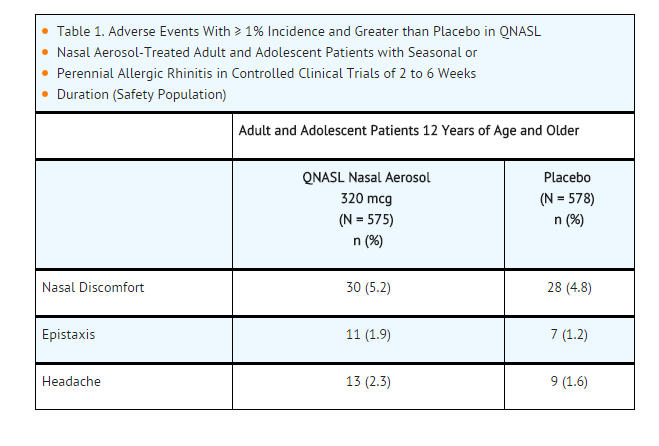
- Nasal ulcerations occurred in 2 patients treated with placebo and in 1 patient treated with QNASL Nasal Aerosol. There were no differences in the incidence of adverse reactions based on gender or race. Clinical trials did not have sufficient numbers of patients aged 65 years and older to determine whether they respond differently than younger patients.
- Long-Term 52-Week Safety Trial: In a 52-week placebo-controlled long-term safety trial in patients with PAR, 415 patients (128 males and 287 females, aged 12 to 74 years) were treated with QNASL Nasal Aerosol at a dose of 320 mcg once daily and 111 patients (44 males and 67 females, aged 12 to 67 years) were treated with placebo. Of the 415 patients treated with QNASL Nasal Aerosol, 219 patients were treated for 52 weeks and 196 patients were treated for 30 weeks. While most adverse events were similar in type and rate between the treatment groups, epistaxis occurred more frequently in patients who received QNASL Nasal Aerosol (45 out of 415, 11%) than in patients who received placebo (2 out of 111, 2%). Epistaxis also tended to be more severe in patients treated with QNASL Nasal Aerosol. In 45 reports of epistaxis in patients who received QNASL Nasal Aerosol, 27, 13, and 5 cases were of mild, moderate, and severe intensity, respectively, while the reports of epistaxis in patients who received placebo were of mild (1) and moderate (1) intensity. Seventeen patients treated with QNASL Nasal Aerosol experienced adverse reactions that led to withdrawal from the trial compared to 3 patients treated with placebo. There were 4 nasal erosions and 1 nasal septum ulceration which occurred in patients who received QNASL Nasal Aerosol, and no erosions or ulcerations noted in patients who received placebo. No patient experienced a nasal septum perforation during the trial.
Pediatric Patients Aged 4 to 11 Years:
- The safety data described below for pediatric patients 4 to 11 years of age with seasonal or perennial allergic rhinitis are based on 3 placebo-controlled clinical trials. These trials were 2 to 12 weeks in duration, evaluated doses of beclomethasone nasal aerosol 80 mcg to 160 mcg once daily and included a total of 1360 patients with either seasonal or perennial allergic rhinitis. Of these, 668 (312 female and 356 male) received at least one dose of QNASL Nasal Aerosol, 80 mcg once daily, 241 (116 female and 125 male) received QNASL Nasal Aerosol 160 mcg once daily, and 451 (203 female and 248 male) received placebo. The racial distribution of patients was 73% white, 20% black, and 6% other. Based on the results from the dose ranging trial, 80 mcg once daily was chosen as the dose in pediatric patients.
- Less than 1.5% of patients in the clinical trials discontinued treatment because of adverse reactions with the rate of withdrawal among patients who received QNASL Nasal Aerosol 80 mcg once daily similar to or lower than the rate among patients who received placebo. Table 2 displays the common adverse reactions (≥ 2% and greater than placebo-treated patients). Additionally, epistaxis was reported at a rate of 4% for both QNASL Nasal Aerosol 80 mcg once daily and placebo treated patients.
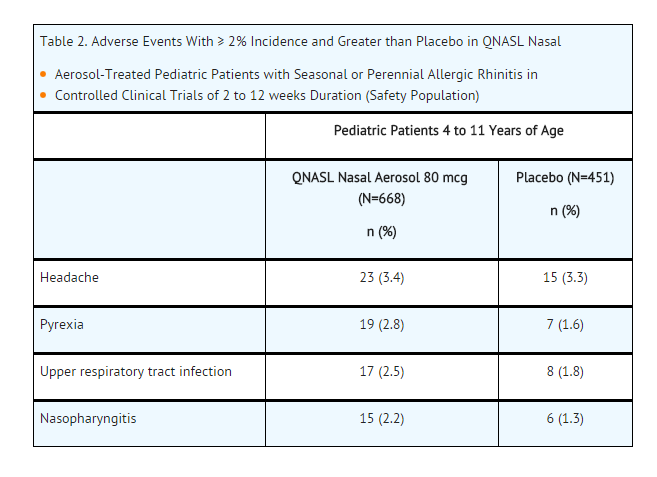
Postmarketing Experience
- In addition to adverse reactions reported from clinical trials for QNASL Nasal Aerosol, the following adverse events have been reported during postmarketing use of QNASL Nasal Aerosol or other intranasal and inhaled formulations of beclomethasone dipropionate. Because these reactions are reported voluntarily from a population of uncertain size, it is not always possible to reliably estimate their frequency or establish a causal relationship to drug exposure. These events have been chosen for inclusion due to either their seriousness, frequency of reporting, or causal connection to beclomethasone dipropionate or a combination of these factors.
QNASL Nasal Aerosol: sneezing, burning sensation
Intranasal beclomethasone dipropionate: Nasal septal perforation, glaucoma, cataracts, loss of taste and smell, and hypersensitivity reactions including anaphylaxis, angioedema, rash, and urticaria have been reported following intranasal administration of beclomethasone dipropionate.
Inhaled beclomethasone dipropionate: Hypersensitivity reactions, including anaphylaxis, angioedema, rash, urticaria, and bronchospasm have been reported following the oral inhalation of beclomethasone dipropionate.
Drug Interactions
There is limited information regarding Beclomethasone dipropionate (nasal) Drug Interactions in the drug label.
Use in Specific Populations
Pregnancy
Pregnancy Category (FDA):
There is no FDA guidance on usage of Beclomethasone dipropionate (nasal) in women who are pregnant.
Pregnancy Category (AUS):
There is no Australian Drug Evaluation Committee (ADEC) guidance on usage of Beclomethasone dipropionate (nasal) in women who are pregnant.
Labor and Delivery
There is no FDA guidance on use of Beclomethasone dipropionate (nasal) during labor and delivery.
Nursing Mothers
There is no FDA guidance on the use of Beclomethasone dipropionate (nasal) with respect to nursing mothers.
Pediatric Use
There is no FDA guidance on the use of Beclomethasone dipropionate (nasal) with respect to pediatric patients.
Geriatic Use
There is no FDA guidance on the use of Beclomethasone dipropionate (nasal) with respect to geriatric patients.
Gender
There is no FDA guidance on the use of Beclomethasone dipropionate (nasal) with respect to specific gender populations.
Race
There is no FDA guidance on the use of Beclomethasone dipropionate (nasal) with respect to specific racial populations.
Renal Impairment
There is no FDA guidance on the use of Beclomethasone dipropionate (nasal) in patients with renal impairment.
Hepatic Impairment
There is no FDA guidance on the use of Beclomethasone dipropionate (nasal) in patients with hepatic impairment.
Females of Reproductive Potential and Males
There is no FDA guidance on the use of Beclomethasone dipropionate (nasal) in women of reproductive potentials and males.
Immunocompromised Patients
There is no FDA guidance one the use of Beclomethasone dipropionate (nasal) in patients who are immunocompromised.
Administration and Monitoring
Administration
- Nasal
- Administer QNASL Nasal Aerosol by the intranasal route only. QNASL Nasal Aerosol must be primed prior to initial use by actuating four times. To do this, remove the protective dust cap from the device, hold the device upright between your thumb and forefinger (index finger) (the canister should be on top, pointing down), and spray 4 times into the air, away from your eyes and face. After the initial priming, the dose counter should read 120 for QNASL 40 mcg Nasal Aerosol and QNASL 80 mcg Nasal Aerosol 120-actuation products and 60 for QNASL 40 mcg Nasal Aerosol 60-actuation product. If QNASL Nasal Aerosol is not used for 7 consecutive days it should be primed by spraying 2 times. See accompanying illustrated Patient Information and Instructions for Use leaflet for proper use of QNASL Nasal Aerosol.
Monitoring
There is limited information regarding Monitoring of Beclomethasone dipropionate (nasal) in the drug label.
IV Compatibility
There is limited information regarding IV Compatibility of Beclomethasone dipropionate (nasal) in the drug label.
Overdosage
Chronic overdosage may result in signs/symptoms of hypercorticism. There are no data available on the effects of acute or chronic overdosage with QNASL Nasal Aerosol.
Pharmacology
There is limited information regarding Beclomethasone dipropionate (nasal) Pharmacology in the drug label.
Mechanism of Action
There is limited information regarding Beclomethasone dipropionate (nasal) Mechanism of Action in the drug label.
Structure
There is limited information regarding Beclomethasone dipropionate (nasal) Structure in the drug label.
Pharmacodynamics
There is limited information regarding Pharmacodynamics of Beclomethasone dipropionate (nasal) in the drug label.
Pharmacokinetics
There is limited information regarding Pharmacokinetics of Beclomethasone dipropionate (nasal) in the drug label.
Nonclinical Toxicology
Carcinogenesis, Mutagenesis, Impairment of Fertility
- The carcinogenicity of beclomethasone dipropionate was evaluated in rats that were exposed for a total of 95 weeks: 13 weeks at inhalation doses up to 0.4 mg/kg and the remaining 82 weeks at combined oral and inhalation doses up to 2.4 mg/kg. In this trial, there was no evidence of carcinogenicity at the highest dose: approximately 70 and 120 times the maximum recommended human daily intranasal dose (MRHDID) in adults and children, respectively, on a mg/m2 basis.
- Beclomethasone dipropionate did not induce gene mutation in bacterial cells or mammalian Chinese hamster ovary (CHO) cells in vitro. No significant clastogenic effect was seen in cultured CHO cells in vitro or in the mouse micronucleus test in vivo.
- In rats, beclomethasone dipropionate caused decreased conception rates at an oral dose of 16 mg/kg (approximately 490 times the MRHDID in adults on a mg/m2 basis). There was no significant effect of beclomethasone dipropionate on fertility in rats at oral doses of 1.6 mg/kg (approximately 50 times the MRHDID in adults on a mg/m2 basis). Inhibition of the estrous cycle in dogs was observed following oral doses of 0.5 mg/kg (approximately 50 times the MRHDID in adults on a mg/m2 basis). No inhibition of the estrous cycle in dogs was seen following 12 months of exposure at an estimated inhalation dose of 0.33 mg/kg (approximately 35 times the MRHDID in adults on a mg/m2 basis).
Clinical Studies
Seasonal and Perennial Allergic Rhinitis
Adult and Adolescent Patients Aged 12 Years and Older: The efficacy and safety of QNASL Nasal Aerosol have been evaluated in 3 randomized, double-blind, parallel-group, multicenter, placebo-controlled clinical trials of 2 to 6 weeks duration in adult and adolescent patients 12 years and older with symptoms of seasonal or perennial allergic rhinitis. The 3 clinical trials included one 2-week dose-ranging trial in patients with seasonal allergic rhinitis, one 2-week efficacy trial in patients with seasonal allergic rhinitis, and one 6-week efficacy trial in patients with perennial allergic rhinitis. The trials included a total of 1049 patients (366 males and 683 females). About 81% of patients were Caucasian and 17% African American, the mean age was approximately 38 years. Of these patients 521 received QNASL Nasal Aerosol 320 mcg once daily administered as 2 actuations in each nostril.
- Assessment of efficacy was based on the total nasal symptom score (TNSS). TNSS is calculated as the sum of the patients' scoring of the 4 individual nasal symptoms (rhinorrhea, sneezing, nasal congestion, and nasal itching) on a 0 to 3 categorical severity scale (0 = absent, 1 = mild, 2 = moderate, 3 = severe) as reflective (rTNSS) or instantaneous (iTNSS). rTNSS required the patients to record symptom severity over the previous 12 hours; iTNSS required the patients to record symptom severity over the previous 10 minutes. Morning and evening TNSS scores were averaged over the treatment period and the difference from placebo in the change from baseline rTNSS was the primary efficacy endpoint. The morning iTNSS reflects the TNSS at the end of the 24-hour dosing interval and is an indication of whether the effect was maintained over the 24-hour dosing interval.
Dose-Ranging Trial: The dose-ranging trial was a 2-week trial that evaluated the efficacy of 3 doses of beclomethasone dipropionate nasal aerosol (80, 160, and 320 mcg, once daily) in patients with seasonal allergic rhinitis. In this trial, only treatment with beclomethasone dipropionate nasal aerosol at the dose of 320 mcg/day resulted in statistically significant improvements compared with placebo in the primary efficacy endpoint, rTNSS (table 3).
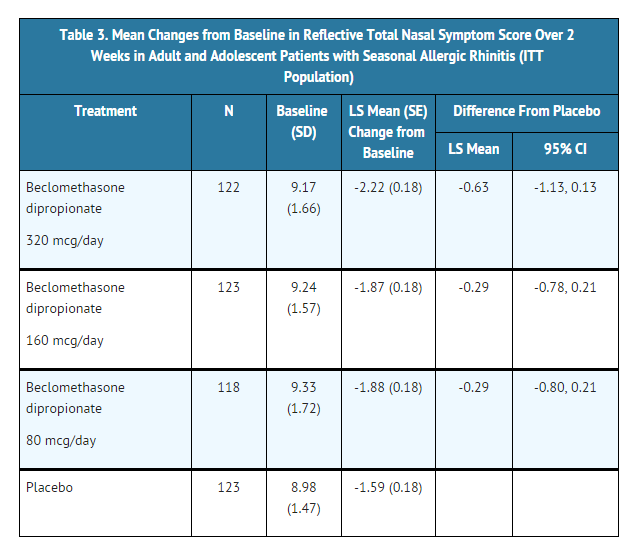
- The 320 mcg dose also demonstrated a statistically significant decrease in morning iTNSS than placebo, indicating that the effect was maintained over the 24-hour dosing interval.
Seasonal and Perennial Allergic Rhinitis Trials: In 2 randomized, double-blind, parallel-group, multicenter, placebo-controlled efficacy trials, once-daily treatment with QNASL Nasal Aerosol for 2 weeks in patients with seasonal allergic rhinitis and for 6 weeks in patients with perennial allergic rhinitis resulted in statistically significant greater decreases from baseline in the rTNSS and morning iTNSS than placebo (table 4).
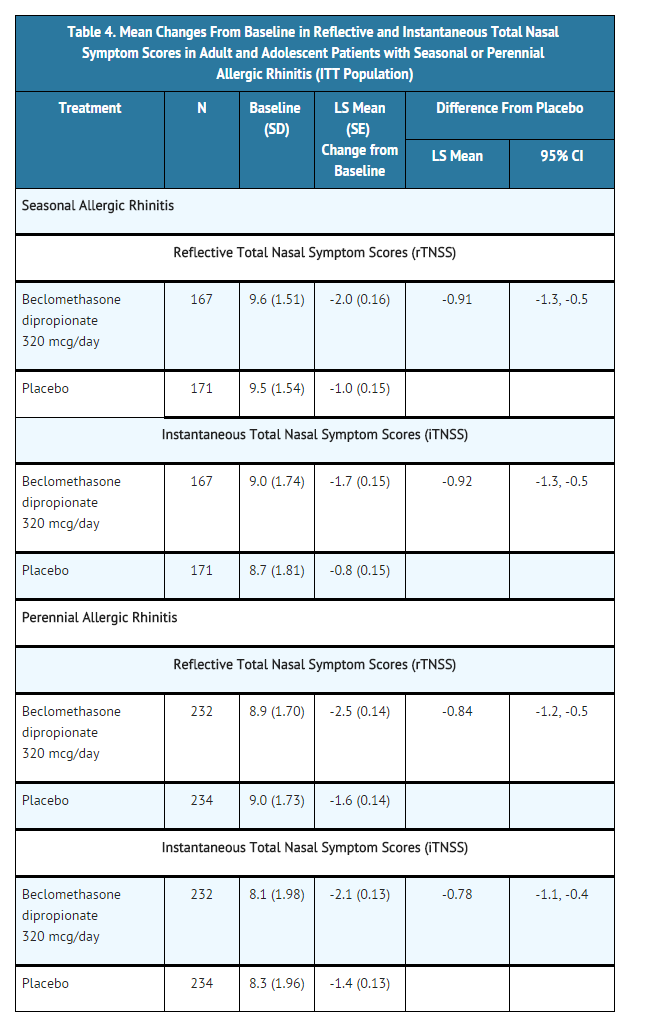
Pediatric Patients 4 to 11 Years of Age: The efficacy and safety of QNASL Nasal Aerosol have been evaluated in 2 randomized, double-blind, parallel-group, multicenter, placebo-controlled clinical trials of 2 to 12 weeks duration in pediatric patients 4 to 11 years of age with symptoms of seasonal or perennial allergic rhinitis. The 2 clinical trials included one 2-week dose-ranging trial in patients with seasonal allergic rhinitis (6 - 11 years of age), and one 12-week efficacy trial in patients with perennial allergic rhinitis (4 - 11 years of age). The trials included a total of 1255 patients (680 males and 575 females). About 73% of patients were Caucasian and 20% African American, the mean age was approximately 8 years for one study and 9 years for the second study. Of these patients 596 received QNASL Nasal Aerosol 80 mcg once daily administered as 1 actuation of QNASL 40 mcg Nasal Aerosol in each nostril.
- Assessment of efficacy was based on the total nasal symptom score (TNSS) as described in adult and adolescents efficacy studies.
Dose-Ranging Seasonal Allergic Rhinitis Trial: The dose-ranging trial was a 2-week trial that evaluated the efficacy of 2 doses of beclomethasone dipropionate nasal aerosol (80 and 160mcg, once daily) in patients with seasonal allergic rhinitis. In this trial, treatment with beclomethasone dipropionate nasal aerosol at the dose of 80 mcg/day resulted in statistically significant improvements compared with placebo in the primary efficacy endpoint, rTNSS (table 5).
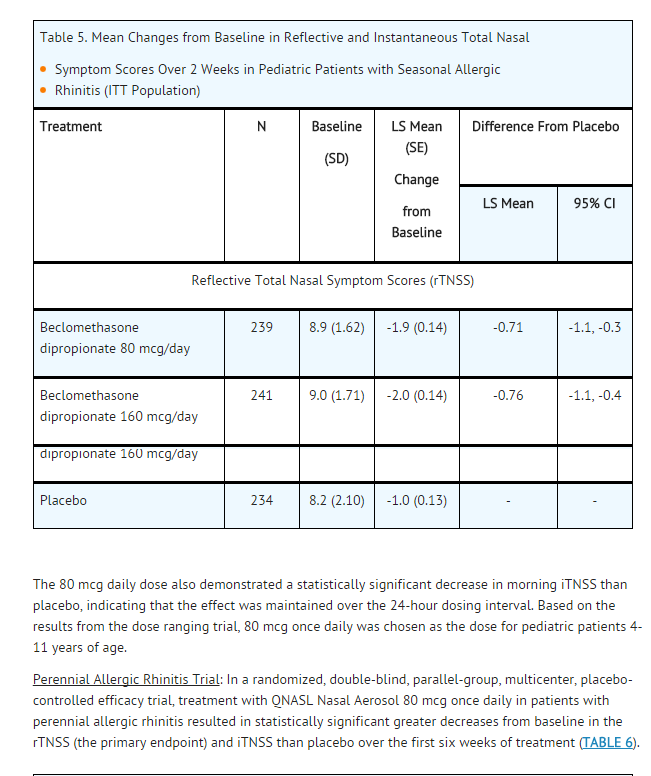
- The 80 mcg daily dose also demonstrated a statistically significant decrease in morning iTNSS than placebo, indicating that the effect was maintained over the 24-hour dosing interval. Based on the results from the dose ranging trial, 80 mcg once daily was chosen as the dose for pediatric patients 4-11 years of age.
Perennial Allergic Rhinitis Trial: In a randomized, double-blind, parallel-group, multicenter, placebo-controlled efficacy trial, treatment with QNASL Nasal Aerosol 80 mcg once daily in patients with perennial allergic rhinitis resulted in statistically significant greater decreases from baseline in the rTNSS (the primary endpoint) and iTNSS than placebo over the first six weeks of treatment (table 6).
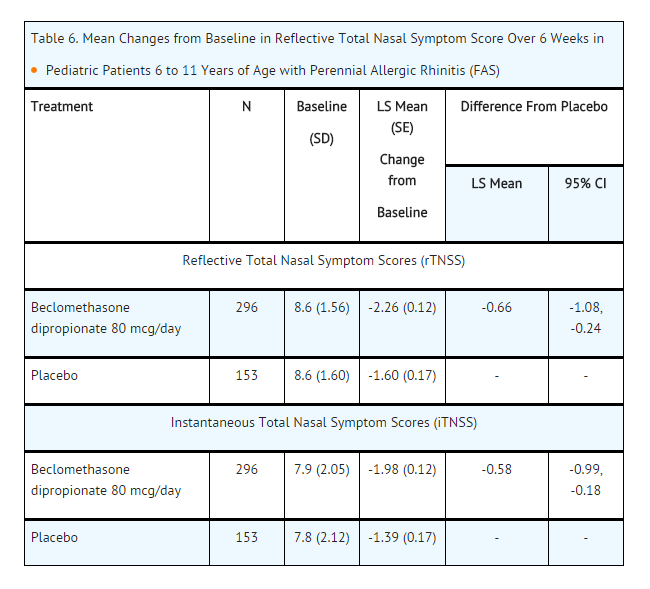
- FAS=full analysis set
- For pediatric patients 4-11 years of age, improvements in average patient-reported rTNSS and iTNSS were also significantly greater in QNASL Nasal Aerosol 80 mcg per day treated patients compared with placebo.
How Supplied
Storage
There is limited information regarding Beclomethasone dipropionate (nasal) Storage in the drug label.
Images
Drug Images
{{#ask: Page Name::Beclomethasone dipropionate (nasal) |?Pill Name |?Drug Name |?Pill Ingred |?Pill Imprint |?Pill Dosage |?Pill Color |?Pill Shape |?Pill Size (mm) |?Pill Scoring |?NDC |?Drug Author |format=template |template=DrugPageImages |mainlabel=- |sort=Pill Name }}
Package and Label Display Panel
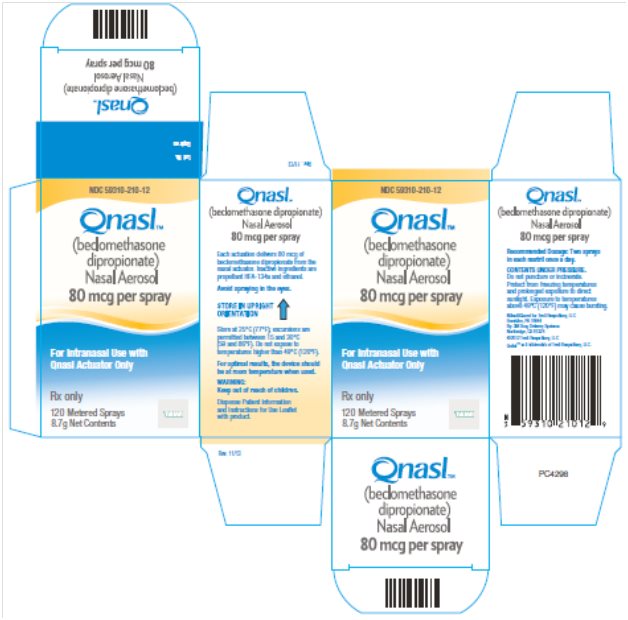
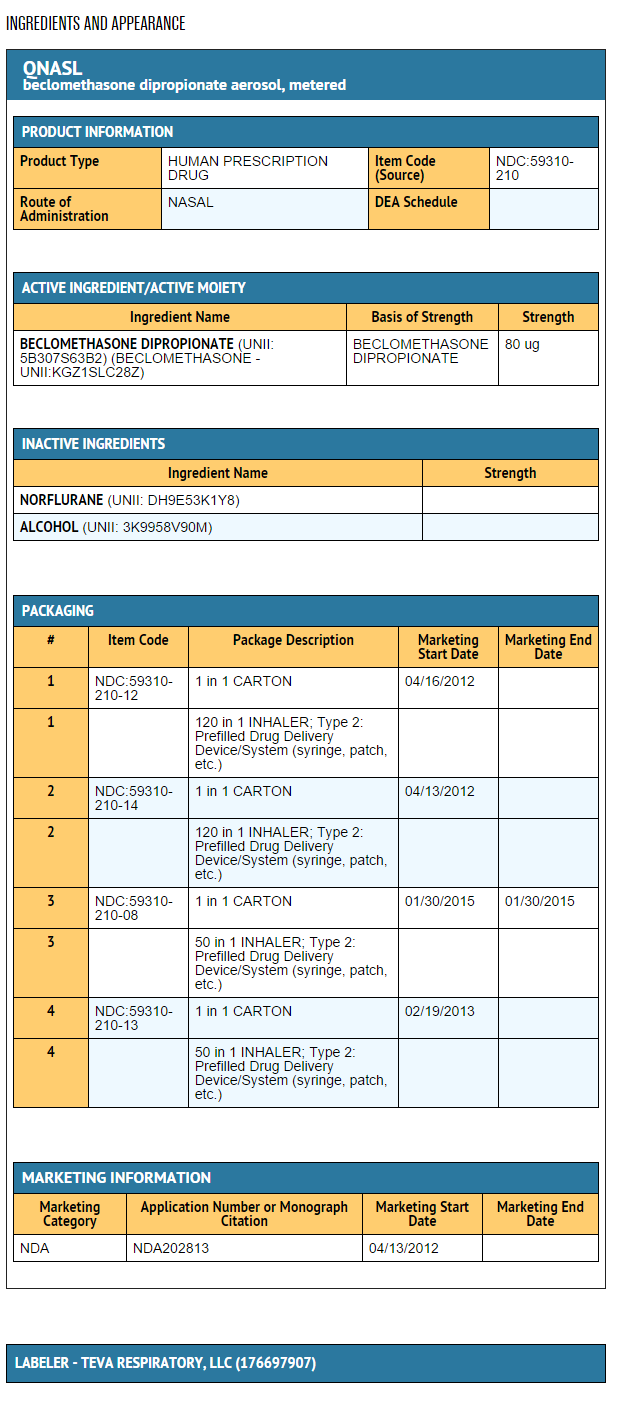
{{#ask: Label Page::Beclomethasone dipropionate (nasal) |?Label Name |format=template |template=DrugLabelImages |mainlabel=- |sort=Label Page }}
Patient Counseling Information
There is limited information regarding Patient Counseling Information of Beclomethasone dipropionate (nasal) in the drug label.
Precautions with Alcohol
- Alcohol-Beclomethasone dipropionate (nasal) interaction has not been established. Talk to your doctor about the effects of taking alcohol with this medication.
Brand Names
- QNASL®[1]
Look-Alike Drug Names
- A® — B®[2]
Drug Shortage Status
Price
References
The contents of this FDA label are provided by the National Library of Medicine.
- ↑ "beclomethasone dipropionate aerosol, metered url = http://dailymed.nlm.nih.gov/dailymed/drugInfo.cfm?setid=a0d4d864-4a45-4f1e-b3e5-d6e09b59c004". External link in
|title=(help); Missing or empty|url=(help) - ↑ "http://www.ismp.org". External link in
|title=(help)
{{#subobject:
|Page Name=Beclomethasone dipropionate (nasal)
|Pill Name=No image.jpg
|Drug Name=
|Pill Ingred=|+sep=;
|Pill Imprint=
|Pill Dosage={{{dosageValue}}} {{{dosageUnit}}}
|Pill Color=|+sep=;
|Pill Shape=
|Pill Size (mm)=
|Pill Scoring=
|Pill Image=
|Drug Author=
|NDC=
}}
{{#subobject:
|Label Page=Beclomethasone dipropionate (nasal) |Label Name=Beclomethasone dipropionate (nasal)11.png
}}
{{#subobject:
|Label Page=Beclomethasone dipropionate (nasal) |Label Name=Beclomethasone dipropionate (nasal)11.png
}}